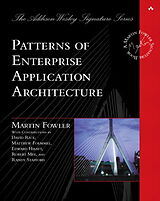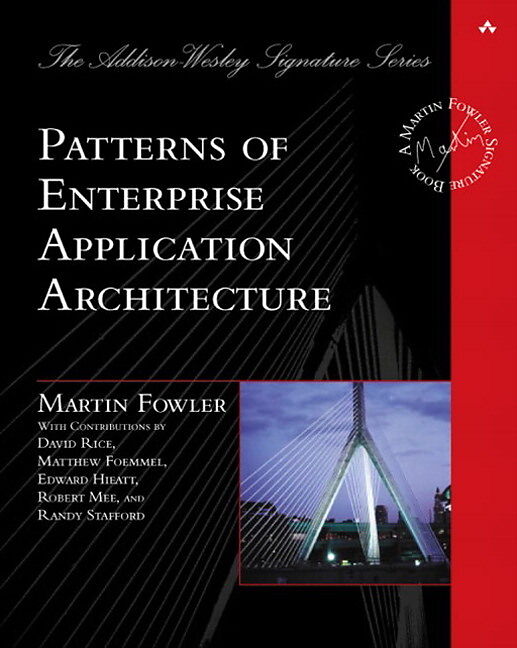Patterns of Enterprise Application Architecture
Einband:
Fester Einband
EAN:
9780321127426
Untertitel:
Addison-Wesley Signature Series
Genre:
Programmiersprachen
Autor:
Martin Fowler
Herausgeber:
Addison Wesley
Auflage:
1. Auflage
Anzahl Seiten:
560
Erscheinungsdatum:
05.11.2002
ISBN:
0321127420
Developers of enterprise applications (e.g reservation systems, supply chain programs, financial systems, etc.) face a unique set of challenges, different than those faced by their desktop system and embedded system peers. For this reason, enterprise developers must uncover their own solutions. In this new book, noted software engineering expert Martin Fowler turns his attention to enterprise application development. He helps professionals understand the complex -- yet critical -- aspects of architecture. While architecture is important to all application development, it is particularly critical to the success of an enterprise project, where issues such as performance and concurrent multi-user access are paramount. The book presents patterns (proven solutions to recurring problems) in enterprise architecture, and the context provided by the author enables the reader to make the proper choices when faced with a difficult design decision.
The practice of enterprise application development has benefited from the emergence of many new enabling technologies. Multi-tiered object-oriented platforms, such as Java and .NET, have become commonplace. These new tools and technologies are capable of building powerful applications, but they are not easily implemented. Common failures in enterprise applications often occur because their developers do not understand the architectural lessons that experienced object developers have learned. Patterns of Enterprise Application Architecture is written in direct response to the stiff challenges that face enterprise application developers. The author, noted object-oriented designer Martin Fowler, noticed that despite changes in technology--from Smalltalk to CORBA to Java to .NET--the same basic design ideas can be adapted and applied to solve common problems. With the help of an expert group of contributors, Martin distills over forty recurring solutions into patterns. The result is an indispensable handbook of solutions that are applicable to any enterprise application platform. This book is actually two books in one. The first section is a short tutorial on developing enterprise applications, which you can read from start to finish to understand the scope of the book's lessons. The next section, the bulk of the book, is a detailed reference to the patterns themselves. Each pattern provides usage and implementation information, as well as detailed code examples in Java or C#. The entire book is also richly illustrated with UML diagrams to further explain the concepts. Armed with this book, you will have the knowledge necessary to make important architectural decisions about building an enterprise application and the proven patterns for use when building them. The topics covered include · Dividing an enterprise application into layers · The major approaches to organizing business logic · An in-depth treatment of mapping between objects and relational databases · Using Model-View-Controller to organize a Web presentation · Handling concurrency for data that spans multiple transactions · Designing distributed object interfaces
Autorentext
Martin Fowler is an independent consultant who has applied objects to pressing business problems for more than a decade. He has consulted on systems in fields such as health care, financial trading, and corporate finance. His clients include Chrysler, Citibank, UK National Health Service, Andersen Consulting, and Netscape Communications. In addition, Fowler is a regular speaker on objects, the Unified Modeling Language, and patterns.
0321127420AB07242003
Klappentext
Patterns of Enterprise Application Architecture is written in direct response to the stiff challenges that face enterprise application developers. The author, noted object-oriented designer Martin Fowler, noticed that despite changes in technology-from Smalltalk to CORBA to Java to .NET-the same basic design ideas can be adapted and applied to solve common problems. With the help of an expert group of contributors, Martin distills over forty recurring solutions into patterns. The result is an indispensable handbook of solutions that are applicable to any enterprise application platform.
Zusammenfassung
Provides information on developing enterprise applications, reference to the patterns, usage and implementation, and code examples in Java or C#. This book, illustrated with UML diagrams to further explain the concepts, covers the division of an enterprise application into layers, approaches to organizing business logic, and more.
Inhalt
Preface.
Who This Book Is For. Acknowledgements. Colophon.
Introduction.
Architecture. Enterprise Applications. Kinds of Enterprise Application. Thinking About Performance. Patterns. The Structure of the Patterns. Limitations of These Patterns. I. THE NARRATIVES. 1. Layering.
The Evolution of Layers in Enterprise Applications. The Three Principal Layers. Choosing Where to Run Your Layers. 2. Organizing Domain Logic.
Making a Choice. Service Layer. 3. Mapping to Relational Databases.
Architectural Patterns. The Behavioral Problem. Reading in Data Structural Mapping Patterns. Mapping Relationships. Inheritance. Building the Mapping. Double Mapping. Using Metadata. Database Connections. Some Miscellaneous Points. Further Reading. 4. Web Presentation.
View Patterns. Input Controller Patterns. Further Reading. 5. Concurrency (by Martin Fowler and David Rice).
Concurrency Problems. Execution Contexts. Isolation and Immutability. Optimistic and Pessimistic Concurrency Control. Preventing Inconsistent Reads. Deadlocks. Transactions. ACID. Transactional Resources. Reducing Transaction Isolation for Liveness. Business and System Transactions. Patterns for Offline Concurrency Control. Application Server Concurrency. Further Reading. 6. Session State.
The Value of Statelessness. Session State. Ways to Store Session State. 7. Distribution Strategies.
The Allure of Distributed Objects. Remote and Local Interfaces. Where You Have to Distribute. Working with the Distribution Boundary. Interfaces for Distribution. 8. Putting it all Together.
Starting With the Domain Layer. Down to the Data Source. Data Source for Transaction Script. Data Source Table Module (125). Data Source for Domain Model (116). The Presentation Layer. Some Technology-Specific Advice. Java and J2EE. .NET. Stored Procedures. Web Services. Other Layering Schemes. II. THE PATTERNS. 9. Domain Logic Patterns.
Transaction Script. How It Works. When to Use It. The Revenue Recognition Problem. Example: Revenue Recognition (Java). Domain Model. How It Works. When to Use It. Further Reading. Example: Revenue Recognition (Java). Table Module. How It Works. When to Use It. Example: Revenue Recognition with a Table Module (C#). Service Layer(by Randy Stafford). How It Works. When to Use It. Further Reading. Example: Re…

Leider konnten wir für diesen Artikel keine Preise ermitteln ...
billigbuch.ch sucht jetzt für Sie die besten Angebote ...
Die aktuellen Verkaufspreise von 6 Onlineshops werden in Realtime abgefragt.
Sie können das gewünschte Produkt anschliessend direkt beim Anbieter Ihrer Wahl bestellen.
Loading...
Die aktuellen Verkaufspreise von 6 Onlineshops werden in Realtime abgefragt.
Sie können das gewünschte Produkt anschliessend direkt beim Anbieter Ihrer Wahl bestellen.
| # | Onlineshop | Preis CHF | Versand CHF | Total CHF | ||
|---|---|---|---|---|---|---|
| 1 | Seller | 0.00 | 0.00 | 0.00 |
